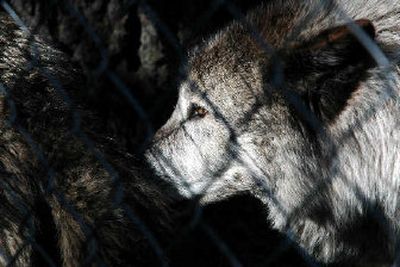Winchester wolves

Wolves, love them or hate them, have become an unmistakable image and symbol for wilderness in Yellowstone and Glacier national parks and North Central Idaho. An estimated 512 wolves live in Idaho, but for most of us, the chance of seeing one in the wild is pretty unlikely. But there is a place where there is a good possibility to not only see a wolf but also to learn about this controversial animal – the Wolf Education and Research Center in Winchester, Idaho.
The wolf has been viewed as a villain by many since we listened to big bad wolf stories as children. Images of huge, snarling beasts, their canine teeth dripping with saliva, might still cause a nightmare for some. Wolves have been seen as something to eliminate for years. Many cattleman and hunters hate them. The predators do sometimes eat the animals we also like to eat – beef cattle, sheep, deer and elk. But humans are not on their menu. In Canada, where there are thousands of gray wolves and many human encounters, wolves are known to simply move on.
The Nez Perce Indian Tribe, which owns the property where the wolf education and research center is located, has been given state responsibility for the wolves that are found in Idaho, with the U.S. Fish and Wildlife Service having oversight authority. Recently, the Idaho Department of Fish and Game has been given that task. Unfortunately, the Nez Perce’s role is now mostly monitoring Idaho wolves, but the Nez Perce take that responsibility seriously. Wild wolves are tracked using radio collars. The tribe’s offices for wolf management are located in McCall.
The Wolf Educational and Research Center at Winchester is run as a nonprofit organization partnered with the tribe but must raise its own funds. The wolves at the center have a colorful history. They were born in captivity and were acquired by movie producer and photographer Jim Dutcherin in 1990. He planned a documentary on gray wolves and these animals were the stars of the show. The location was in the Sawtooth Mountains near Stanley, Idaho. The film, “Wolf, Return of a Legend,” won a 1994 Emmy Award for nature photography.
But after the filming was finished, what was to be done with the pack of wolves? Dutcherin found that the Nez Perce Tribe was a willing recipient of the 12 wolves and, with his help, built a 20-acre, double-fenced enclosure for them.
It was decided that the animals would be sterilized and no more pups would be born in captivity. Consequently, the adults are slowly dying off from natural causes. There are still several wolves that routinely show themselves to the public. There is a self-guided tour (one-third off a mile) and the wolves may or may not show up by the fences. There is also a guided tour (one-half mile) which allows viewing between the double fences. The wolves are more likely to come nearby and may even lick your hand if it is pressed against the fence. That is a unique, friendly, close encounter with a wolf. Guided tours should be reserved in advance.
The visitor center has been built near the wolf enclosure. The organization is dedicated to providing public education and scientific research concerning the gray wolf and its habitat. There are interactive and wall displays concerning wolf behavior.
Forever controversial, wolves are now being recommended by the Idaho Fish and Game Department to be 75 percent eliminated in the Nez Perce and Clearwater national forests. The Wolf Education and Research Center is presently fighting that Fish and Game recommendation.
If the trip to the wolf center is planned as an overnight outing, a fairly unknown state park is close by the town of Winchester. By the way, the story goes that the town got its name in an unusual way. In the early days, a meeting was called to come up with a town name. Someone suggested, after noticing all the rifles leaning against the wall near the front door, that the name be chosen for whatever gun manufacturer had the most guns in the room.
Winchester State Park offers 69 campsites, including some RV sites with power and water. For those who do not have the camping equipment, there are four yurts. Staying in a yurt is a comfortable step up from tent camping. But you still have to bring sleeping bags and cooking utensils. Cooking is done on an open grill outside the yurt.
For those who have never slept in one, a yurt is a circular, domed tent, 20 feet in diameter with plywood, lattice sidewalls and a clear Plexiglas skylight. It has a framed-in, lockable wood door and windows with screens. It is covered entirely by waterproof canvas. It is heated and furnished with beds to sleep up to six people.
Viewing live wolves at the Wolf Education and Research Center, combined with an overnight stay in a yurt, could provide a fun, unique experience for the entire family. But don’t be disappointed if snarling, people-eating animals are nowhere to be found.